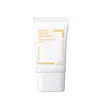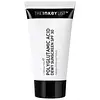What's inside
What's inside
 Key Ingredients
Key Ingredients

 Benefits
Benefits

 Concerns
Concerns

 Ingredients Side-by-side
Ingredients Side-by-side

Butyl Methoxydibenzoylmethane 2.5%
UV AbsorberHomosalate 7%
Skin ConditioningWater 4.3%
Skin ConditioningButyloctyl Salicylate
Skin ConditioningButylene Glycol
HumectantEthylhexyl Methoxycrylene
Skin ConditioningArachidyl Alcohol
EmollientBehenyl Alcohol
EmollientPolymethylsilsesquioxane
1,2-Hexanediol
Skin ConditioningCetyl Alcohol
EmollientArachidyl Glucoside
EmulsifyingPhenoxyethanol
PreservativePropanediol
SolventPolyacrylate Crosspolymer-6
Emulsion StabilisingOctyldodecanol
EmollientGlyceryl Stearate
EmollientPEG-100 Stearate
Parfum
MaskingXanthan Gum
EmulsifyingLimonene
PerfumingCentella Asiatica Extract
CleansingPortulaca Oleracea Extract
Skin ConditioningEchium Plantagineum Seed Oil
Skin ConditioningT-Butyl Alcohol
PerfumingCamellia Sinensis Leaf Extract
AntimicrobialLinalool
PerfumingEthylhexylglycerin
Skin ConditioningHelianthus Annuus Seed Oil Unsaponifiables
EmollientCardiospermum Halicacabum Flower/Leaf/Vine Extract
Skin ConditioningTocopherol
AntioxidantHelianthus Annuus Seed Oil
EmollientGlycerin
HumectantHamamelis Virginiana Leaf Extract
Skin ConditioningCitrus Unshiu Peel Extract
MaskingOpuntia Coccinellifera Fruit Extract
Skin ConditioningOrchid Extract
Skin ConditioningCamellia Japonica Leaf Extract
Skin ConditioningCitric Acid
BufferingSodium Benzoate
MaskingPotassium Sorbate
PreservativeButyl Methoxydibenzoylmethane 2.5%, Homosalate 7%, Water 4.3%, Butyloctyl Salicylate, Butylene Glycol, Ethylhexyl Methoxycrylene, Arachidyl Alcohol, Behenyl Alcohol, Polymethylsilsesquioxane, 1,2-Hexanediol, Cetyl Alcohol, Arachidyl Glucoside, Phenoxyethanol, Propanediol, Polyacrylate Crosspolymer-6, Octyldodecanol, Glyceryl Stearate, PEG-100 Stearate, Parfum, Xanthan Gum, Limonene, Centella Asiatica Extract, Portulaca Oleracea Extract, Echium Plantagineum Seed Oil, T-Butyl Alcohol, Camellia Sinensis Leaf Extract, Linalool, Ethylhexylglycerin, Helianthus Annuus Seed Oil Unsaponifiables, Cardiospermum Halicacabum Flower/Leaf/Vine Extract, Tocopherol, Helianthus Annuus Seed Oil, Glycerin, Hamamelis Virginiana Leaf Extract, Citrus Unshiu Peel Extract, Opuntia Coccinellifera Fruit Extract, Orchid Extract, Camellia Japonica Leaf Extract, Citric Acid, Sodium Benzoate, Potassium Sorbate
Water
Skin ConditioningOctocrylene
UV AbsorberGlycerin
HumectantEthylhexyl Salicylate
UV AbsorberCoco-Caprylate/Caprate
EmollientButyl Methoxydibenzoylmethane
UV AbsorberPhenylbenzimidazole Sulfonic Acid
UV AbsorberTriheptanoin
Skin ConditioningSaccharomyces Ferment
Skin ConditioningCetearyl Alcohol
EmollientGlyceryl Stearate Se
EmulsifyingTromethamine
BufferingGlyceryl Caprylate
EmollientPropanediol
SolventC9-12 Alkane
SolventDilinoleic Acid/Butanediol Copolymer
Sodium Stearoyl Glutamate
CleansingHydroxyethyl Acrylate/Sodium Acryloyldimethyl Taurate Copolymer
Emulsion StabilisingDimethicone
EmollientSqualane
EmollientHectorite
AbsorbentLauroyl Lysine
Skin ConditioningHydroxyethylcellulose
Emulsion StabilisingCaprylhydroxamic Acid
Dimethiconol
EmollientPolysorbate 60
EmulsifyingAcrylates/C10-30 Alkyl Acrylate Crosspolymer
Emulsion StabilisingOryza Sativa Hull Extract
MoisturisingCastor Oil/Ipdi Copolymer
Phenoxyethanol
PreservativePolyglutamic Acid
Skin ConditioningSorbitan Isostearate
EmulsifyingCamellia Sinensis Leaf Extract
AntimicrobialIpomoea Batatas Root Extract
Skin ConditioningHydroxyacetophenone
AntioxidantSodium Benzoate
Masking1,2-Hexanediol
Skin ConditioningCaprylyl Glycol
EmollientLactobacillus Ferment Lysate
Skin ConditioningSaccharomyces Lysate
Skin ConditioningWater, Octocrylene, Glycerin, Ethylhexyl Salicylate, Coco-Caprylate/Caprate, Butyl Methoxydibenzoylmethane, Phenylbenzimidazole Sulfonic Acid, Triheptanoin, Saccharomyces Ferment, Cetearyl Alcohol, Glyceryl Stearate Se, Tromethamine, Glyceryl Caprylate, Propanediol, C9-12 Alkane, Dilinoleic Acid/Butanediol Copolymer, Sodium Stearoyl Glutamate, Hydroxyethyl Acrylate/Sodium Acryloyldimethyl Taurate Copolymer, Dimethicone, Squalane, Hectorite, Lauroyl Lysine, Hydroxyethylcellulose, Caprylhydroxamic Acid, Dimethiconol, Polysorbate 60, Acrylates/C10-30 Alkyl Acrylate Crosspolymer, Oryza Sativa Hull Extract, Castor Oil/Ipdi Copolymer, Phenoxyethanol, Polyglutamic Acid, Sorbitan Isostearate, Camellia Sinensis Leaf Extract, Ipomoea Batatas Root Extract, Hydroxyacetophenone, Sodium Benzoate, 1,2-Hexanediol, Caprylyl Glycol, Lactobacillus Ferment Lysate, Saccharomyces Lysate
 Reviews
Reviews

Ingredients Explained
These ingredients are found in both products.
Ingredients higher up in an ingredient list are typically present in a larger amount.
1,2-Hexanediol is a synthetic liquid and another multi-functional powerhouse.
It is a:
- Humectant, drawing moisture into the skin
- Emollient, helping to soften skin
- Solvent, dispersing and stabilizing formulas
- Preservative booster, enhancing the antimicrobial activity of other preservatives
Also known as Avobenzone, this ingredient is a chemical sunscreen filter that provides protection in the UV-A range.
Avobenzone is globally approved and is the most commonly used UV-A filter in the world.
Studies have found that avobenzone becomes ineffective when exposed to UV light (it is not photostable; meaning that it breaks down in sunlight). Because of this, formulations that include avobenzone will usually contain stabilizers such as octocrylene.
However, some modern formulations (looking at you, EU!) are able to stabilize avobenzone by coating the molecules.
Avobenzone does not protect against the UV-B range, so it's important to check that the sunscreen you're using contains other UV filters that do!
The highest concentration of avobenzone permitted is 3% in the US, and 5% in the EU.
Learn more about Butyl MethoxydibenzoylmethaneCamellia Sinensis Leaf Extract is derived from the leaves of the tea plant. Black tea, green tea, and oolong tea are all harvested from this plant.
This ingredient has many skin benefits:
This ingredient contains polyphenols, a strong antioxidant. Antioxidants help fight off molecules that damage skin cells.
On top of that, the antioxidants in green tea neutralize free-radicals from the sun. This gives the skin some extra UV protection, but should not replace sunscreen.
Many components of tea have anti-inflammatory properties.
Polyphenols and L-theanine help soothe the skin and reduce irritation. The caffeine in Camellia Sinensis Leaf Extract helps calm inflamed blood vessels.
Other compounds found in tea include: Vitamin Bs, linoleic acid, magnesium, calcium, iron, and zinc.
Research has shown both drinking Camellia Sinensis Leaf Tea and applying it to the skin can help boost skin elasticity and hydration. Studies also show using tea extract may reduce sebum, or oil, production.
Learn more about Camellia Sinensis Leaf ExtractGlycerin is already naturally found in your skin. It helps moisturize and protect your skin.
A study from 2016 found glycerin to be more effective as a humectant than AHAs and hyaluronic acid.
As a humectant, it helps the skin stay hydrated by pulling moisture to your skin. The low molecular weight of glycerin allows it to pull moisture into the deeper layers of your skin.
Hydrated skin improves your skin barrier; Your skin barrier helps protect against irritants and bacteria.
Glycerin has also been found to have antimicrobial and antiviral properties. Due to these properties, glycerin is often used in wound and burn treatments.
In cosmetics, glycerin is usually derived from plants such as soybean or palm. However, it can also be sourced from animals, such as tallow or animal fat.
This ingredient is organic, colorless, odorless, and non-toxic.
Glycerin is the name for this ingredient in American English. British English uses Glycerol/Glycerine.
Learn more about GlycerinPhenoxyethanol is a preservative that has germicide, antimicrobial, and aromatic properties. Studies show that phenoxyethanol can prevent microbial growth. By itself, it has a scent that is similar to that of a rose.
It's often used in formulations along with Caprylyl Glycol to preserve the shelf life of products.
Propanediol is an all-star ingredient. It softens, hydrates, and smooths the skin.
It’s often used to:
Propanediol is not likely to cause sensitivity and considered safe to use. It is derived from corn or petroleum with a clear color and no scent.
Learn more about PropanediolSodium Benzoate is a preservative. It's used in both cosmetic and food products to inhibit the growth of mold and bacteria. It is typically produced synthetically.
Both the US FDA and EU Health Committee have approved the use of sodium benzoate. In the US, levels of 0.1% (of the total product) are allowed.
Sodium benzoate works as a preservative by inhibiting the growth of bacteria inside of cells. It prevents the cell from fermenting a type of sugar using an enzyme called phosphofructokinase.
It is the salt of benzoic acid. Foods containing sodium benzoate include soda, salad dressings, condiments, fruit juices, wines, and snack foods.
Studies for using ascorbic acid and sodium benzoate in cosmetics are lacking, especially in skincare routines with multiple steps.
We always recommend speaking with a professional, such as a dermatologist, if you have any concerns.
Learn more about Sodium BenzoateWater. It's the most common cosmetic ingredient of all. You'll usually see it at the top of ingredient lists, meaning that it makes up the largest part of the product.
So why is it so popular? Water most often acts as a solvent - this means that it helps dissolve other ingredients into the formulation.
You'll also recognize water as that liquid we all need to stay alive. If you see this, drink a glass of water. Stay hydrated!
Learn more about Water